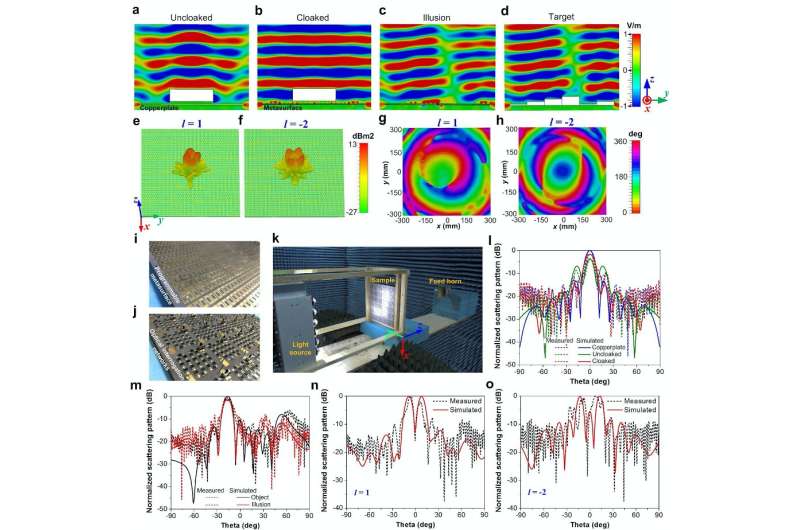March 30, 2020 feature
An optically driven digital metasurface to bridge visible light and microwave communications

Coding, digital, and programmable metasurfaces are engineered surfaces that can be used to manipulate electromagnetic waves, first introduced by Prof. Tie Jun Cui and his colleagues in 2014. Due to their many advantageous characteristics, these artificial structures have recently become the focus of a number of research studies.
In addition to realizing the functions they are programmed to complete, programmable metasurfaces can control electromagnetic waves and digital information simultaneously. This unique feature allows them to act as a bridge between physical and digital worlds. Despite this favorable quality, most coding, digital and programmable metasurfaces developed so far are quite complex and require a vast amount of bulky hardware components.
Researchers at Southeast University in China have recently developed a new optically driven digital metasurface that can be programmed to implement electromagnetic functions. The structure they created, presented in a paper published in Nature Electronics, could help researchers to overcome some of the limitations of digital metasurfaces introduced in previous studies.
"Most existing digital coding and programmable metasurfaces require electrical wires, complex control circuits and bulky power supplies," Wei Xiang Jiang, one of the researchers who carried out the study, told TechXplore. "To solve the problem, we tried to find a way to remove these electrical wires and complex control circuits."
Back in 2015, Jiang and his colleagues fabricated a light-controlled transformation-dc device based on a resistor network, embedded with light-sensitive semiconducting resistors. In their new study, they used the same concept of light control at the core of this device to design and realize an optically driven programmable metasurface.
"The main objectives of our work were to eliminate the cross-talk between the DC signal and microwave signal, and to realize non-contact remote programmable meta-systems," Wei Xiang said. "To realize a specific function, we first need to design visible light illumination patterns, which will be convert to the voltages biased to the metasurface elements by the optical interrogation network. Then, the metasurface will generate specific microwave reflection phase distributions and realize different functions in programmable way."
The optically driven artificial structure developed by Wei Xiang and his colleagues has 6 x 6 subarrays, each containing 4 x 4 metasurface elements based on electronic varactors. These elements are combined with an optical network made of photodiodes that can convert visible light patterns into voltages and ultimately produce specific microwave reflection phase distributions.
In contrast with digital and programmable metasurfaces introduced in previous studies, the new metasurface can operate within a broad range of bandwidths and can be programmed remotely. This means that it does not require wires and other bulky power sources.
"The most important features of our programmable system include light weight, small size, and wireless tuning," Wei Xiang explained. "Moreover, we can use the light intensity to control the microwave phase, which could be of value in developing hybrid electronic-photonic devices and systems for more advanced electronic and communication systems."
The optically driven system proposed by this team of researchers can ultimately as a bridge between visible light and microwave communications. In the future, it could enable the development of lighter, more advanced electronics and communication devices.
So far, Wei Xiang and his colleagues have demonstrated the capabilities of their metasurface by programming it to perform three key functions: external cloaking, illusion, and dynamic vortex beam generation. However, the same structure could also potentially be programmed for a variety of other applications.
"We are now planning to start investigating a visible light and microwave hybrid communication system based on the fabricated optically driven programmable metasurface that can convert the light signal to the microwave signal," Wei Xiang added.
More information: Xin Ge Zhang et al. An optically driven digital metasurface for programming electromagnetic functions, Nature Electronics (2020). DOI: 10.1038/s41928-020-0380-5
Tie Jun Cui et al. Coding metamaterials, digital metamaterials and programmable metamaterials, Light: Science & Applications (2014). DOI: 10.1038/lsa.2014.99
Wei Xiang Jiang et al. An Optically Controllable Transformation-dc Illusion Device, Advanced Materials (2015). DOI: 10.1002/adma.201500729
© 2020 Science X Network





















